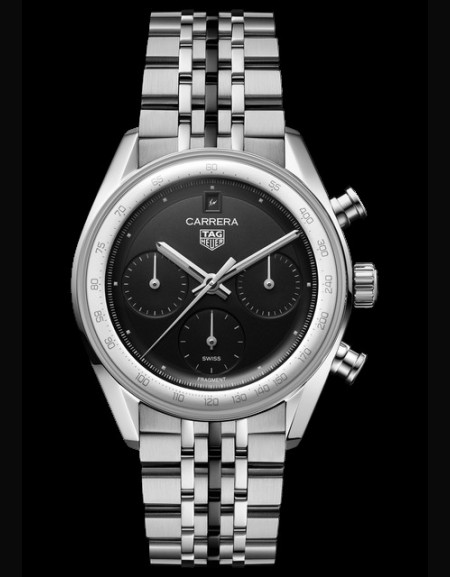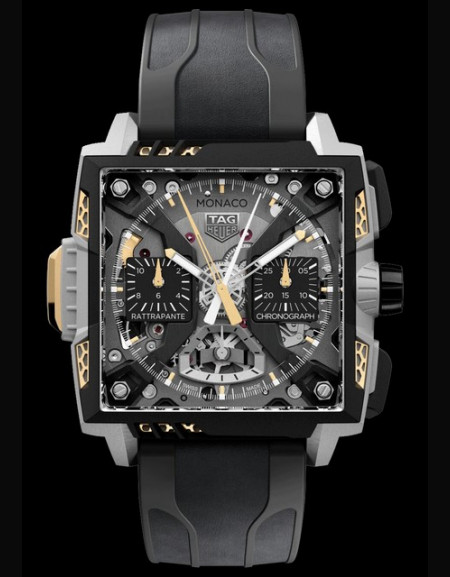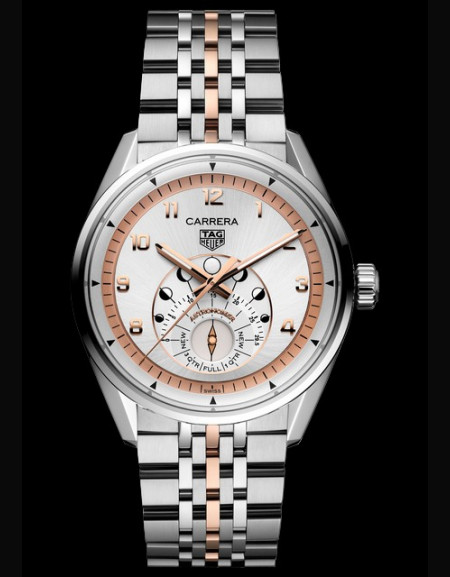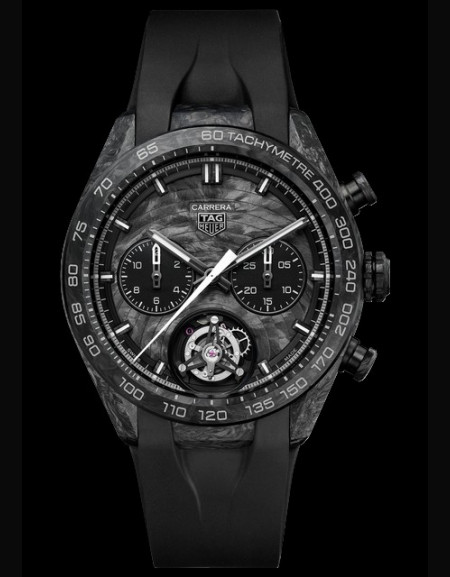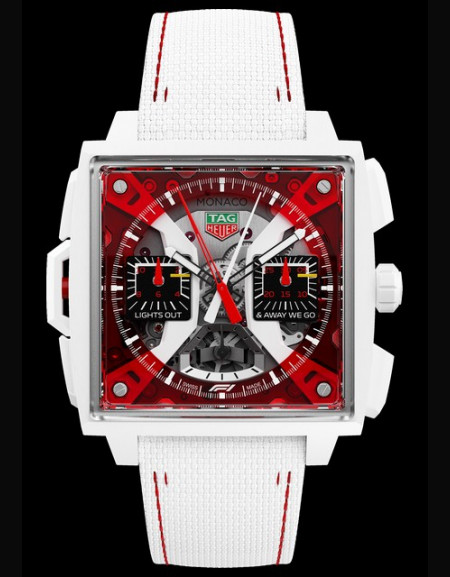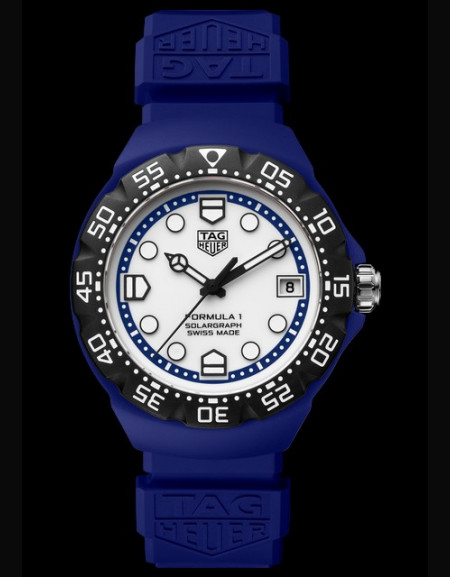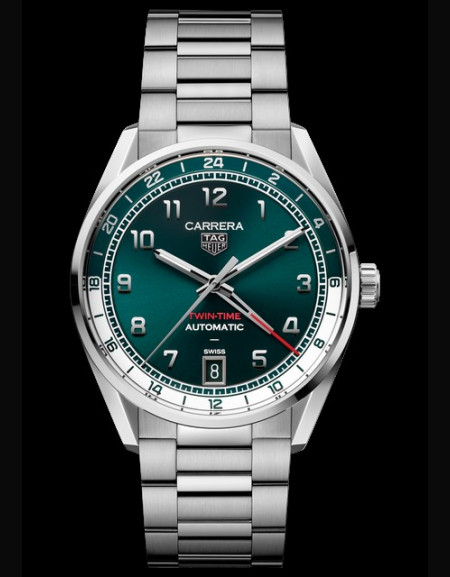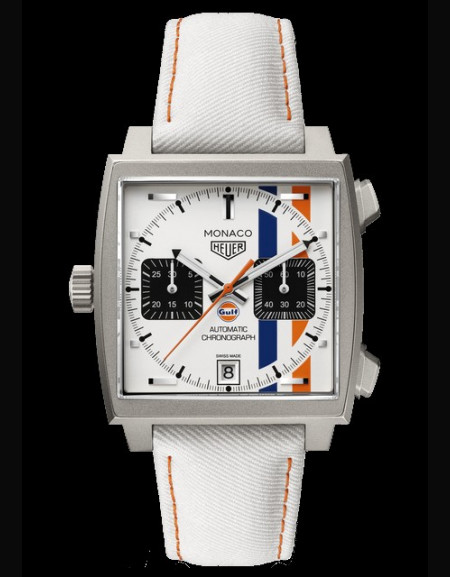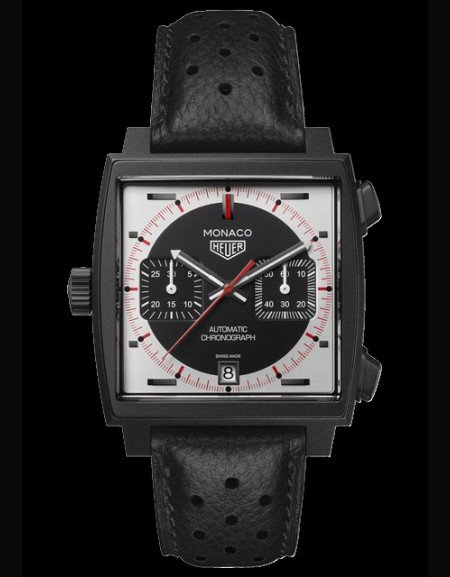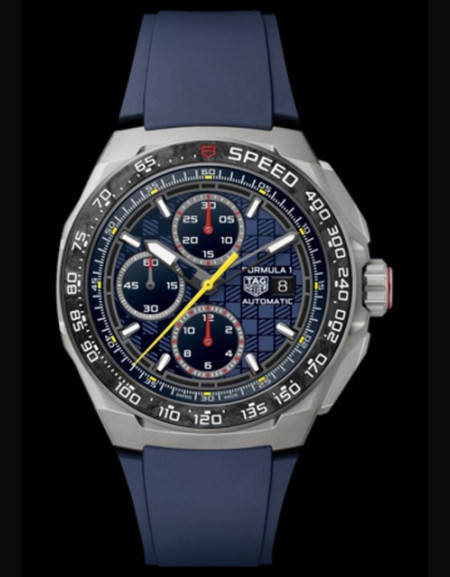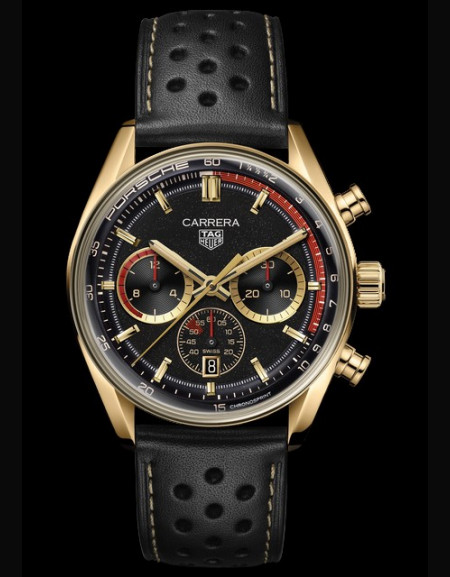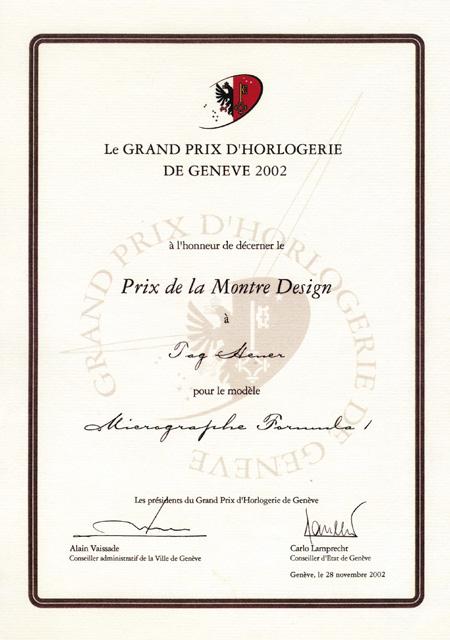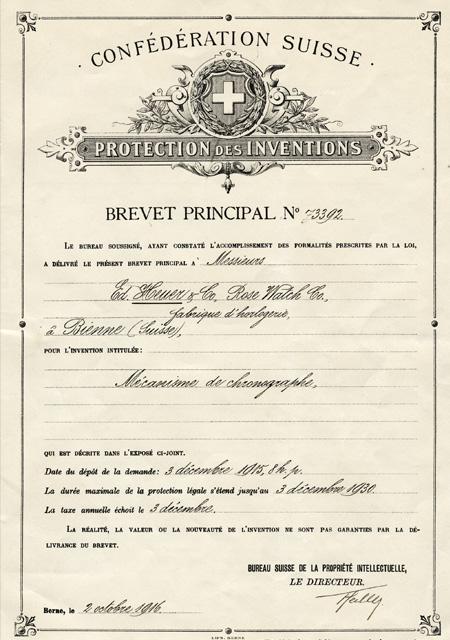1
tag_heuer

|
||
TAG Heuer history
1876: Edouard Heuer establishes a subsidiary establishment in London.
1882: As sporting competitions rapidly expanded, measuring time accurately became increasingly important. Edouard Heuer acted upon this and, in 1882...

THE COLLECTIONS

-
TAG Heuer Carrera...
SEE THE DATA SHEETBrand: TAG Heuer
Collection: CARRERA
Ref: CBS221B.BA0045
Price: 9 000 € -
Monaco Split-Seconds...
SEE THE DATA SHEETBrand: TAG Heuer
Collection: MONACO
Ref: CBW218B.FT8124
Price: 160 000 € -
Carrera Astronomer
SEE THE DATA SHEETBrand: TAG Heuer
Collection: CARRERA
Ref: WBX2111.BD0002
Price: 7 150 € -
Carrera Astronomer
SEE THE DATA SHEETBrand: TAG Heuer
Collection: CARRERA
Ref: WBX2110.BA0044
Price: 4 700 € -
Carrera Astronomer
SEE THE DATA SHEETBrand: TAG Heuer
Collection: CARRERA
Ref: WBX2112.FC6615
Price: 4 500 € -
Carrera Chronograph...
SEE THE DATA SHEETBrand: TAG Heuer
Collection: CARRERA
Ref: CBU5091.FT6305
Price: 41 500 € -
Monaco Flyback...
SEE THE DATA SHEETBrand: TAG Heuer
Collection: MONACO
Ref: CBL5190.FT6313
Price: 17 700 € -
Monaco Split-Seconds...
SEE THE DATA SHEETBrand: TAG Heuer
Collection: MONACO
Ref: CBW2190.FC8356
Price: 155 000 € -
Formula 1 Solargraph
SEE THE DATA SHEETBrand: TAG Heuer
Collection: FORMULA 1
Ref: WBY1162.FT8105
Price: 1 800 € -
Formula 1 Solargraph
SEE THE DATA SHEETBrand: TAG Heuer
Collection: FORMULA 1
Ref: WBY1161.FT8086
Price: 1 800 € -
Formula 1 Solargraph
SEE THE DATA SHEETBrand: TAG Heuer
Collection: FORMULA 1
Ref: WBY1160.FT8085
Price: 1 800 € -
Formula 1 Solargraph
SEE THE DATA SHEETBrand: TAG Heuer
Collection: FORMULA 1
Ref: WBY111A.FT8106
Price: 1 800 € -
Formula 1 Solargraph
SEE THE DATA SHEETBrand: TAG Heuer
Collection: FORMULA 1
Ref: WBY1117.FT8087
Price: 1 800 € -
Formula 1 Solargraph
SEE THE DATA SHEETBrand: TAG Heuer
Collection: FORMULA 1
Ref: WBY1114.FT8084
Price: 1 800 € -
Formula 1 Solargraph
SEE THE DATA SHEETBrand: TAG Heuer
Collection: FORMULA 1
Ref: WBY1113.BA0042
Price: 1 900 € -
Formula 1 Solargraph
SEE THE DATA SHEETBrand: TAG Heuer
Collection: FORMULA 1
Ref: WBY1112.BA0042
Price: 1 900 € -
Formula 1 Solargraph
SEE THE DATA SHEETBrand: TAG Heuer
Collection: FORMULA 1
Ref: WBY1111.BA0042
Price: 1 900 € -
Carrera Date Twin-Time
SEE THE DATA SHEETBrand: TAG Heuer
Collection: CARRERA
Ref: WDA2114.BA0043
Price: 4 800 € -
Carrera Day-Date
SEE THE DATA SHEETBrand: TAG Heuer
Collection: CARRERA
Ref: WDA2113.BA0043
Price: 4 150 € -
Carrera Day-Date
SEE THE DATA SHEETBrand: TAG Heuer
Collection: CARRERA
Ref: WDA2112.BA0043
Price: 4 150 € -
Carrera Day-Date
SEE THE DATA SHEETBrand: TAG Heuer
Collection: CARRERA
Ref: WDA2111.BD0001
Price: 8 350 € -
Carrera Day-Date
SEE THE DATA SHEETBrand: TAG Heuer
Collection: CARRERA
Ref: WDA2111.BA0043
Price: 4 350 € -
Carrera Day-Date
SEE THE DATA SHEETBrand: TAG Heuer
Collection: CARRERA
Ref: WDA2110.FC6614
Price: 3 950 € -
Monaco Chronograph x Gulf
SEE THE DATA SHEETBrand: TAG Heuer
Collection: MONACO
Ref: CAW218G.EB0393
Price: 9 400 € -
Monaco Chronograph Stopwatch
SEE THE DATA SHEETBrand: TAG Heuer
Collection: MONACO
Ref: CAW218F.FC6356
Price: 9 650 € -
Formula 1 Chronograph
SEE THE DATA SHEETBrand: TAG Heuer
Collection: FORMULA 1
Ref: CBZ2080.FT8091
Price: 5 350 € -
Formula 1 Chronograph
SEE THE DATA SHEETBrand: TAG Heuer
Collection: FORMULA 1
Ref: CBZ2086.FT8098
Price: 4 850 € -
Formula 1 Chronograph
SEE THE DATA SHEETBrand: TAG Heuer
Collection: FORMULA 1
Ref: CBZ2084.FT8097
Price: 4 850 € -
Formula 1 Chronograph
SEE THE DATA SHEETBrand: TAG Heuer
Collection: FORMULA 1
Ref: CBZ2085.FT8093
Price: 4 850 € -
Formula 1 Chronograph
SEE THE DATA SHEETBrand: TAG Heuer
Collection: FORMULA 1
Ref: CBZ2082.FT8096
Price: 4 650 € -
Carrera Chronosprint x...
SEE THE DATA SHEETBrand: TAG Heuer
Collection: CARRERA
Ref: CBS2041.EB0382
Price: 24 200 € -
Carrera Chronosprint x...
SEE THE DATA SHEETBrand: TAG Heuer
Collection: CARRERA
Ref: CBS2015.EB0381
Price: 10 050 €
TAG Heuer history
1876: Edouard Heuer establishes a subsidiary establishment in London.
1882: As sporting competitions rapidly expanded, measuring time accurately became increasingly important. Edouard Heuer acted upon this and, in 1882, he became one of the first to produce pocket chronographs in large quantities.
1887: He patented one of the most important innovations in watchmaking: the famous Oscillating Pinion, still used to this day by leading manufacturers in the production of mechanical chronographs. The revolutionary device has allowed the chronograph to function very neatly by replacing the two large wheels of the anterior movements. With this breakthrough invention, TAG Heuer became the reference standard in chronographs and timing instruments for high-level sports.
1889: At the Universal Exhibition in Paris, the company was awarded a silver medal for its pocket chronograph collection.
1892: Edouard dies on April 30th at the age of 52. His creative vision and passion for innovation had laid the foundation for a watchmaking dynasty—one that was destined to make an indelible mark on the century that followed.
1895: Patent of the TAG Heuer water-resistant case.
1908: The company obtains a patent for a Pulsometer dial still used today by doctors.
1910: Henri Freund & Bros. takes on the distribution of Heuer products for the American market.
1911: The Time of Trip, patented in 1911, was the first 12-hour dashboard chronograph for cars and aircraft.
TAG Heuer creates the ‘Monte-Carlo' pocket size counter for Roulette and Lotto, with a hand winding movement. It was more a roulette wheel for the vest pocket than a watch movement.
1912: Heuer begins producing women's wristwatches.
1913: the first TAG Heuer advertising appears.
1914: The first wrist-worn chronographs.
1916: At the beginning of the 20th century, the timekeeping world was confronted with the challenge of increasing precision. Thus, in 1916, the Mikrograph and Microsplit, and Semikrograph and Semicrosplit, were born. These were the world's first mechanical stopwatches that were accurate to 1/100th of a second and 1/50th of a second, respectively. At that time, other timing instruments could only measure to the nearest 1/5th of a second. This new development revolutionized science, industry, and watchmaking, and made TAG Heuer the natural choice as an official supplier of chronographs for the Olympic Games.
1920: Tag Heuer is the official supplier of chronographs for the Olympic Games in Antwerp.
1923: Hebert Heuer, the youngest son of Charles-Auguste Heuer, joins the company at the beginning of the year as U.S. commercial director.
1924: Tag Heuer is the official supplier of chronographs for the Olympic Games in Paris.
1928: Tag Heuer is the official supplier of chronographs for the Olympic Games in Amsterdam.
1929: Hugo Eckener equipped his Graf Zeppelin with this instrument before completing the first round-the-world trip in an airship.
1930: In the 1930s, the company proved itself, serving as the timekeeper of the speed-skiing race in St. Moritz and the Bobsleigh World Championship in Caux.
1931: Professor Auguste Piccard, a specialist of cosmic radiation, led the first stratospheric flight.
1933: The company launched the Autavia (a combination of "AUTomobile" and "AVIAtion"), the first onboard stopwatch for cars and aircraft. TAG Heuer's cutting-edge chronographs soon appeared on the wrists of famous people around the world, including Harry S. Truman, Dwight D. Eisenhower, Henry Ford, Prince William of Sweden, and King Bhumibol of Thailand.
1947: TAG Heuer presented August Piccard with another chronograph featuring hands with no radium, so it would not interfere with the cosmic-ray measurements. Hergé based the Professor Calculus character in the Tintin comic books on Profes- sor Piccard.
1950: when TAG Heuer unveiled its patented Mareograph, a unique sailing chronograph derived from the earlier Solunar watch, which let fishermen know when fish were feeding. Called the Seafarer in the United States, the new chronograph was the first with a tide indicator and a five-minute countdown function for sailing competitions.
1955: In 1955, TAG Heuer unveiled the Twin-Time, a GMT model that displayed two time zones simultaneously. In 1958, the company presented its famous onboard timer, the Rally-Master, consisting of a Master-Time (eight-day clock) and a Monte- Carlo (12-hour stopwatch). The following year, Hubert Heuer and his nephew, Jack Heuer (son of Charles-Edouard), set up Heuer Time Corporation, a new American subsidiary based in New York.
1958: Jack Heuer, Charles-Edouard Heuer's son, joins the company.
1959: Jack Heuer sets up the Heuer Timer Corporation as a subsidiary in the USA.
1962: On February 20, 1962, American astronaut John Glenn wore a TAG Heuer stopwatch when he piloted the Friendship 7 spacecraft on Mercury-Atlas 6, the first manned U.S. orbital mission, making TAG Heuer the first Swiss watchmaker in space!
1964: Jack Heuer turned to his overriding passion for motor rac- ing with the inaugural launch of the legendary TAG Heuer Carrera.
1965: Jack Heuer unveiled a prototype of the Slalom Timer at the Basel Watch Fair. It was the company's first miniaturized electronic timing instrument ac- curate to 1/100th of a second. The electronic revolution had begun.
1966: Jack Heuer stunned the watchmaking world again, this time by introducing the Microtimer, the world's first miniaturized electronic timing instrument accurate to an extraordinary 1/1,000th of a second.
1969: the Swiss driver Jo Siffert signed on as a TAG Heuer brand ambassador, becoming the first racing driver sponsored by a watch manufacturer. At the beginning of the '60s, Jack Heuer reached an agreement with two other Swiss watch manufacturers to create the world's first automatic chronograph movement. They gave their top-secret project the confidential code name "99". The new Chronomatic Calibre 11 was launched in 1969. This first chronograph movement with an automatic micro-rotor mechanism powered both the TAG Heuer Carrera and Autavia, and also the legendary Monaco. This original automatic chronograph with a square, water-resistant case achieved a near-mythological status when Steve McQueen wore it in the film Le Mans (1971).
1971 - 1979: As Ferrari's Official Timekeeper from 1971 to 1979, the brand played a key role in the team's unprecedented string of world-championship victories, and saw its name linked to Ferrari legends such as Gilles Villeneuve, Niki Lauda, and Jody Scheckter.
1973: In 1973, the Microsplit 820 was unveiled, the first pocket quartz timing instrument precise to 1/100th of a second.
1975: TAG Heuer launched the Chronosplit, the world's first quartz wrist chronograph with a double digital display LCD/LED. The LCD on top showed the time of the day and the LED showed the stopped time to a precision of 1/10th of a second. Enzo Ferrari personally ordered 15 of these special Ferrari models. Other famous customers, such as Paul Newman, soon joined the ranks of Chronosplit owners. Just two years later, the company presented the world's first digital-analog chronograph, the Chronosplit Manhattan GMT, forerunner of the Kirium Formula 1 chronograph.
1982: The launch of the 2000 series in 1982 reinforced the unparalleled sporting spirit of the brand. This contemporary sports watch became an industry bench-mark due to its six features: water-resistance up to 200 meters, a unidirectional turning bezel, luminescent hands and markers, a screw-in crown with a double gasket to ensure water resistance, a double-safety clasp, and scratch-resistant, sapphire-crystal glass.
1985: TAG Heuer teamed up with McLaren Mercedes, forming what would become one of the longest-running and most successful partnerships in Formula One history; TAG Heuer was soon linked to some of the team's most famous drivers, including Alain Prost, Ayrton Senna, and Mika Häkkinen.
1988: Carl Lewis, one of the best track and field athlete, becomes a TAG Heuer ambassador.
1996: TAG Heuer relaunched three of its classic series: TAG Heuer Carrera in 1996, Monaco in 1998, and Monza in 2001.
1999: The company introduced the Link series, a bold reworking of the hugely successful S/el design.
2001: the Kirium Formula 1 represented the future direction of sports-watch design and a major technical achievement: a modern analog watch with digital chronograph functions and 1/100th-of-a-second precision. That same year, TAG Heuer became Official Timekeeper of the FIS Alpine Ski World Championships in St. Anton, Austria.
Jack Heuer becomes Honorary Chairman of TAG Heuer.
2002: In 2002, the Micrograph F1, a descendant of the legendary Mikrograph of 1916, was awarded the Design Prize at the Grand Prix d'Horlogerie de Genève. It combined the aesthetics of a celebrated watch with the functions of a high-per- formance professional timekeeping instrument, and featured lap-measuring with a precision of 1/100th of a second, as well as a high-end digital screen for maximum readability. During this year, the company sponsored the BMW Oracle Racing team for the America's Cup with Chris Dickson and Peter Holmberg. the long-awaited Sportvision line of optical and sun eyewear was launched, thrusting TAG Heuer's sporting prestige into an entirely new domain. The Physics range of the eyewear series received a prestigious Red Dot Design Award.
2003: TAG Heuer launched the Microtimer, fitted with the first Swiss electronic movement offering a remarkable precision of 1/1,000th of a second. A masterpiece of the miniaturization of complex electronics, the Microtimer is based on technology adapted from the demanding world of Formula One racing.
2004: In 2004, the company took on a new motor-racing challenge when it became the Official Timekeeper of the Indy Racing League (IRL) and the legendary Indy 500. No other racing circuit requires timing precision to 1/10,000th of a second. TAG Heuer took the watchmaking world by surprise when it launched a revolutionary concept watch at Baselworld 2004: the Monaco V4. Inspired by the brand's motor-racing heritage (the watch's name comes from the engine-like V-formation of the movement's four barrels), this mechanical watch overturned basic watch-making principles by featuring driving belts, linear mass, and ball bearings instead of conventional wheels and pinions. A totally new type of watch movement, it is considered the most astonishing advancement in mechanical watchmaking of the last decade, and it received a Red Dot Design Award in 2005.
2005: The Monaco Sixty Nine, another concept watch, went into full production in 2004, just a year after being unveiled at Baselworld. The first reversible watch with two different movements—one side features the Monaco dial with its mechani- cal hand-wound movement, the other the digital dial of the Microtimer with its 1/1,000th-of-a-second quartz chronograph movement—won the desirable Design Watches Prize at the Grand Prix d'Horlogerie de Genève.
In 2005, TAG Heuer gave depth and allure to its "Sports and Glamour" emphasis by signing new brand ambassadors: tennis superstar Maria Sharapova, Hollywood legends Uma Thurman and Brad Pitt, and racing aces Juan Pablo Montoya and Kimi Räikkönen. The same year, Uma Thurman's favorite timepiece, the Haute Couture Dia- mond Fiction, was awarded the Ladies' Watches Prize at the Grand Prix d'Horlogerie de Genève. Fifty-four of its 879 diamonds display the time by channeling the light emitted by 54 LEDs. In 2005, the first-ever Professional Golf Watch was launched, developed with the rigorous participation of Tiger Woods. It would go on to win a Chicago Athenaeum Good Design Award (2006) and a Fennia Prize (2007).
2006: The TAG Heuer Carrera Calibre 360 Rose Gold Limited Edition, a prestige version of the Calibre 360 Concept Chronograph, won the Sports Watches Prize at the Grand Prix d'Horlogerie de Genève.
2007: The TAG Heuer Aquaracer Calibre S revolutionized watchmaking with a groundbreaking innovation in chronograph movements: an in-house calibre which made it possible to measure and display watch, chronograph, and regatta functions with the same hands, thanks to its revolutionary "hybrid" construction comprising 230 electromechanical components. Patented for its synchronized bi- directional engines, reading format, and design concept, the chronograph won the prestigious Popular Science "Best of What's New" award in 2007. It also dazzled the watchmaking world with the launch of the Link Calibre S, a new chronograph movement accurate to 1/100th of a second that combines the precision of quartz with the sophistication of mechanical functions.
Introduced in 2007, the TAG Heuer Grand CARRERA is a premium collection of sophisticated timepieces, inspired by the spirit of modern GT cars and powered by the exclusive TAG Heuer Calibre RS, the first line of mechanical movements engineered with a rotating system.
2008: At Baselworld 2008, the company presented the TAG Heuer Grand CARRERA Calibre 36 RS Caliper Concept Chronograph, the first automatic chronograph capable of measuring and displaying 1/10th of a second, thanks to its "Caliper" rotating scale. In 2008, it won the distinguished China's Most Successful Design Award, the Best Chronograph Prize at the Salón Internacional de Alta Relojería in Mexico, the Sports Watches Prize at the Grand Prix d'Horlogerie de Genève, and a Red Dot Design Award in 2009.
TAG Heuer unveils his new exhibition area, the TAG Heuer 360 museum, a historical and avant-garde gallery dedicated to the glory of its exceptional heritage. Inaugurated in La Chaux-de-Fonds on January 30th 2008, during a ceremony inaugurated by Lewis Hamilton and many others.
2009: THE 40TH ANNIVERSARY OF THE MONACO
Four decades after capturing the world's attention by appearing on the wrist of cinema legend Steve McQueen in the racing feature Le Mans, TAG Heuer's iconic Monaco chronograph was reissued in 2009 as a limited-edition timepiece. TAG Heuer also launched the new Aquaracer 500M Calibre 5, the ultimate luxury watch inspired by the essence of water sports. Water-resistant to 500 meters, each model in this collection is equipped with the attributes of a high-performance diving watch, including a helium valve and a unidirectional turning bezel that ensures precise elapsed dive-time measurement. Highly luminescent markers on the hands and indexes, as well as an orange-tipped second hand, provide at-a-glance readability, either under water or in dim light. Additionally, the sapphire crystal and case back are scratch-resistant and anti-reflective for optimum visibility.
2010: Together with Jack Heuer, and as a tribute to the pioneer of the automatic chronograph, TAG Heuer has decided to produce the Calibre 1887, a movement developed entirely in-house. At the same time, engineers in the TAG Heuer Quality Department are working on the Monaco V4. The Calibre 1887 and the Monaco V4—along with the new Calibre Mikrograph 1/100th, an improvement of the Calibre 360 from 2005—will form a trilogy of exceptional movements that TAG Heuer will present in 2010, on the occasion of its 150th anniversary.
